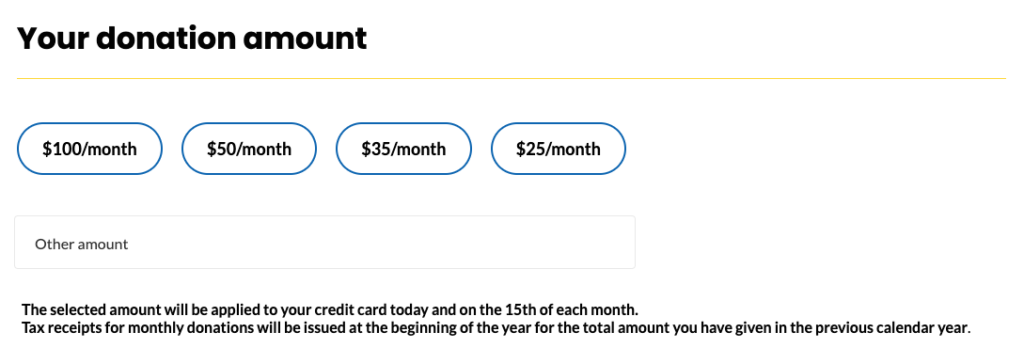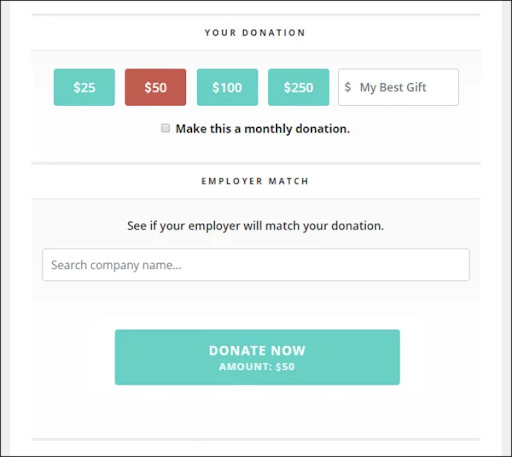Every fundraising strategy should include a plan for identifying prospects.
If you’re running a major gift fundraising program, you need to identify wealthy donors connected to your cause. And for a planned giving program, you need to target your most loyal donors.
But, when it comes to recurring giving, there’s no clear way to find the perfect pool of prospects. Identifying the right recurring donor prospects requires analyzing subtle engagement patterns and donation activity. This article will discuss tips and tools you need to identify prospects and convert more donors to your recurring giving program:
Who is a Recurring Donor?
A recurring donor is someone who donates to a nonprofit organization regularly. This could be someone who gives every month, year, or even two years. Many nonprofits define a recurring donor as someone who gives at least once every 365 days. If a donor doesn’t give again after 365 days, they would be considered a lapsed donor.
For fundraisers, the preferred type of recurring donors are those who give monthly. These donors’ contributions are key to an impactful and sustainable fundraising program. It’s crucial for fundraisers to implement strategies to attract recurring donors who are more likely to contribute monthly.
FREE Donor Profile Template for Fundraisers
Use this template to record and track your donor characteristics so you can target the right individuals for the right campaigns.
What are the Benefits of Acquiring Monthly Donors?
Monthly giving is a recurring donation program where donors automatically contribute a specified amount to an organization each month. Monthly giving campaigns are popular in the nonprofit sector, and rightly so.
Here are four benefits of having monthly donors:
1. Boosts Fundraising Revenue
Monthly donors contribute 40% more than one-time donors over a year. They present nonprofits with an additional, sustainable source of fundraising revenue; and allow nonprofit organizations to cover overhead costs and other recurring expenses.
2. Offers a Flexible Giving Option
Monthly giving is a preferred donation method for several donors, especially younger donors. 60% of millennials report being interested in monthly giving. More so, 45% of this age cohort have given online and are comfortable using digital wallets and online payment systems to make donations.
3. Aids Revenue Forecasting
Having monthly donors means you can make accurate predictions about your nonprofit’s future revenue. Furthermore, having guaranteed income allows nonprofit professionals to allocate program expenses confidently and create a more sustainable and impactful organization.
4. Foster Better Donor Relationships
While we tend to reduce fundraising to financial transactions, it’s really the art of instilling the joy of giving in others.
Monthly giving programs allow donors to meaningfully support a mission they care about. Additionally, by observing how their monthly donations impact beneficiaries, donors will feel more fulfilled and likely to increase their contributions.
That said, a recurring donor base can be challenging to develop. The Fundraising Effectiveness Project found that only 12.3% of first-time donors are retained annually, and that percentage rises to 35.4% for recurring donors. This means that nonprofits need to do a better job retaining their first-time donors to reap the benefits of running a successful recurring giving program.
Let’s Do the Math
To put these statistics into perspective, if you gained 100 new donors this year, you would likely only retain 12 of them the following year.
Continuing this trend over a five-year period, you’d only retain 60 donors: 12 recurring donors per year x 5 years
Of these 60, given the 35.4% donor retention rate for recurring donors, you’d only end up with 21 donors after those five years.
This calculation demonstrates two things:
- Nonprofits with a large donor pool have the best chance of securing recurring donors. It’s critical to acquire as many new donors as possible in order to find as many recurring donor prospects as possible.
- Nonprofits can do more to secure recurring donors. Most donors in your database have only given once, and this presents an immense opportunity for your organization. Unfortunately, most organizations don’t capitalize on the potential of their one-time donors.
5 Best Practices For Growing Your Recurring Giving Program
1. Leverage Predictive Analytics Tools
For fundraisers, it’s impossible to manually review all your donor data to identify and rank recurring donor prospects. There are too many donor engagement metrics and data points, and fundraisers simply don’t have the time to make the necessary calculations.
However, with the right predictive analytics tools, you can pick up on subtle indicators of a recurring donor. These tools can segment your recurring donor prospects to help you organize a targeted appeal.
With KIT’s Recurring Donor feature, you can identify the ideal prospects in a matter of minutes! KIT studies donation behavior, interaction data, and donor characteristics to produce a list of prospects likely to become recurring donors.
Identify More Recurring Donors
KIT helps you uncover contacts likely to become recurring donors so you can develop a larger and more sustainable revenue stream.
2. Make the Right Ask
Now that you have the right pool of prospects; you need to ask them for the right amount. Making the right ask can increase the likelihood of securing a gift and ensure you don’t underestimate your donor’s giving potential.
You can do this with recurring donors by suggesting donation amounts that they might feel comfortable with. Check out the Canadian Cancer Society’s website for a good example of a monthly giving form for new donors:

Smart fundraising CRMs can recommend donation ranges for specific donors and donor segments. You can use that information to approach donors with the right ask and create donation forms that are more likely to convert.
3. Offer Monthly Giving Option in All Fundraising Appeals
To maximize the exposure of your monthly giving program, you should include it as an option in all online donation forms. This way, you won’t miss out on any first-time donors willing to jump right into monthly giving.
Here’s an example of a generic donation form with a monthly giving option:

Be sure to add monthly giving options to your email appeals, donation forms on your website, and any other marketing material. Make these options a fundamental part of your fundraising strategy.
4. Use Mobile Responsive Donation Forms and Appeal
Millennial and Gen-Z donors are more likely to contribute to a monthly giving program; 40% of millennials are enrolled in a monthly giving program. These donors spend more time using mobile devices, so be sure your donation forms and nonprofit website are mobile-friendly.
5. Prioritize Donor Stewardship
To retain monthly donors, you need to create a donor stewardship plan that keeps them engaged with your nonprofit for a long time. Here are some steps you can take:
a) Call Monthly Donors Annually
Consider calling your monthly donors annually to thank them for their contributions. This is a great way to express your gratitude authentically. Such personal interactions can go a long way to making donors feel more connected to your organization and mission.
b) Create and Share Personalized Impact Reports
A personalized impact report should highlight individual donors’ contributions and the campaigns that benefit from them. Showing donors exactly how their contributions impact your mission will motivate them to keep supporting your organization.
c) Notify Donors about Subscription Renewals
If applicable, let your donors know when their recurring donation subscription is coming to an end and needs to be renewed. This way, you can renew their monthly plan before it’s too late. Similarly, let donors know if their payment method is expiring soon.
d) Highlight Monthly Donors in Your Annual Report
You can reserve a section in your annual report for recognizing monthly donors. Many donors will appreciate the gesture and opportunity to be featured alongside your impact stories in your year-end report.
Create Your Next Annual Report with this FREE Template
Use this template to demonstrate your impact, communicate your team’s performance, and promote organizational transparency.
Don’t forget to ask your monthly donors how they’d like to be recognized. It’s crucial to personalize recognition as much as possible. With consistent and personalized stewardship, you will retain more recurring donors and boost your fundraising ROI.
Recurring gifts are an opportunity for your donors to be involved with your organization in more ways than they typically would. With the tips and tools discussed in this article, you can motivate more donors to contribute a monthly donation while increasing the sustainability of your organization.

Jack Showers
Nonprofit Research Analyst at KIT
When Jack isn’t cheering for the Raptors or watching an 80s action movie, he’s studying the social sector and producing content for nonprofit professionals. As a Nonprofit Research Analyst at KIT, an AI-powered insights and reporting toolkit, he is especially passionate about helping fundraisers save time and raise more money for their cause.







